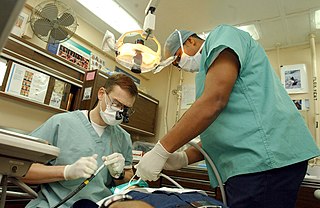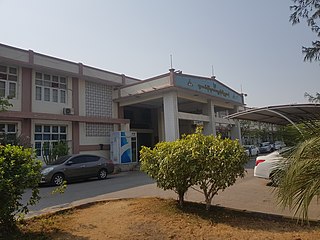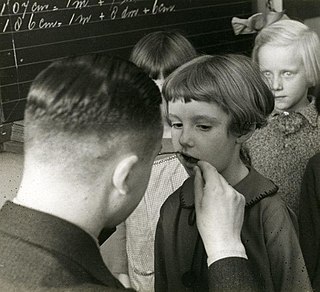
Dentistry, also known as dental medicine and oral medicine, is the branch of medicine focused on the teeth, gums, and mouth. It consists of the study, diagnosis, prevention, management, and treatment of diseases, disorders, and conditions of the mouth, most commonly focused on dentition as well as the oral mucosa. Dentistry may also encompass other aspects of the craniofacial complex including the temporomandibular joint. The practitioner is called a dentist.

A dentist, also known as a dental surgeon, is a health care professional who specializes in dentistry, the branch of medicine focused on the teeth, gums, and mouth. The dentist's supporting team aids in providing oral health services. The dental team includes dental assistants, dental hygienists, dental technicians, and sometimes dental therapists.
Oral and maxillofacial surgery is a surgical specialty focusing on reconstructive surgery of the face, facial trauma surgery, the oral cavity, head and neck, mouth, and jaws, as well as facial cosmetic surgery/facial plastic surgery including cleft lip and cleft palate surgery.
Prosthodontics, also known as dental prosthetics or prosthetic dentistry, is the area of dentistry that focuses on dental prostheses. It is one of 12 dental specialties recognized by the American Dental Association (ADA), Royal College of Surgeons of England, Royal College of Surgeons of Edinburgh, Royal College of Surgeons of Ireland, Royal College of Surgeons of Glasgow, Royal College of Dentists of Canada, and Royal Australasian College of Dental Surgeons. The ADA defines it as "the dental specialty pertaining to the diagnosis, treatment planning, rehabilitation and maintenance of the oral function, comfort, appearance and health of patients with clinical conditions associated with missing or deficient teeth or oral and maxillofacial tissues using biocompatible substitutes."

The Harvard School of Dental Medicine (HSDM) is the dental school of Harvard University. It is located in the Longwood Medical Area in Boston, Massachusetts. In addition to the DMD degree, HSDM offers specialty training programs, advanced training programs, and a PhD program through the Harvard Graduate School of Arts and Sciences. The program considers dentistry a specialty of medicine. Therefore, all students at HSDM experience dual citizenship between Harvard School of Dental Medicine and Harvard Medical School. Today, HSDM is the smallest school at Harvard University with a total student body of 280.

The UCLA School of Dentistry is the dental school of the University of California, Los Angeles (UCLA) located in the Center for Health Sciences building in the Westwood neighborhood of Los Angeles, California, United States. The school has several educational and training programs, conducts oral and dental health research, and offers affordable dental care at three locations: Westwood, Venice, and Inglewood. The school also participates in several outreach endeavors, including numerous health fairs during the year, STEM pipeline programs and provides dental care for underserved populations in the region. The School of Dentistry is considered among the nation's best research-intensive dental schools.

The Boston University Henry M. Goldman School of Dental Medicine is the dental school of Boston University. Its curriculum is based on the Applied Professional Experience (APEX) Program, which gives students practical experience at a dental practice as part of clinical training. The School has about 800 students in predoctoral and postdoctoral programs.
The University of Pittsburgh School of Dental Medicine is the dental school of the University of Pittsburgh (Pitt). It is located in Pittsburgh, Pennsylvania, United States. It is one of Pitt's six schools of the health sciences and one of several dental schools in Pennsylvania. It is closely affiliated with the University of Pittsburgh Medical Center. The School of Dental Medicine accepted 3.6% of applicants for the class of 2016, a record low for the school's entire history.

Dentistry throughout the world is practiced differently, and training in dentistry varies as well.
The Melbourne Dental School is one of the graduate schools of the University of Melbourne. In addition to the 4-year graduate dental program the Doctor of Dental Surgery, the school offers specialty training programs combined with the Doctor of Clinical Dentistry degree, advanced training programs, and research degrees including M.Sc. and Ph.D. programs. According to the QS World Rankings, it is the highest ranking dental school in Australia and often ranks among the top 25 in the world.
A dental school is a tertiary educational institution—or part of such an institution—that teaches dental medicine to prospective dentists and potentially other dental auxiliaries. Dental school graduates receive a degree in Dentistry, Dental Surgery, or Dental Medicine, which, depending upon the jurisdiction, might be a bachelor's degree, master's degree, a professional degree, or a doctorate. Schools can also offer postgraduate training in general dentistry, and/or training in endodontics, oral and maxillofacial surgery, oral pathology, oral and maxillofacial radiology, orthodontics, pedodontics, periodontics, prosthodontics, dental public health, restorative dentistry, as well as postgraduate training for dental hygienists and dental technicians.
University of Otago Faculty of Dentistry is one of the faculties of the University of Otago.
The University of Dental Medicine, Yangon, is the leading university of dental medicine, located in Yangon, Myanmar. The university, along with the University of Dental Medicine, Mandalay, is one of only two universities of dental medicine in the country. The annual intake into both dental universities used to be 300 but from 2017 the annual intake for each university has been decreased to only 100. The country with a population of over 50 million had only about 1,500 dentists in 2005.

The Ohio State University College of Dentistry is one of the graduate and professional schools of Ohio State University. The college is the fourth largest public dental school in the U.S. and consists of nine academic divisions representing all major dental specialties. In addition to the Doctor of Dental Surgery (D.D.S.) and Bachelor of Science in Dental Hygiene degrees, the Ohio State College of Dentistry offers specialty training programs, advanced training programs, MS programs, and a Ph.D. program in Oral Biology. Outreach and Engagement activities include over 60 active programs and more than 42 extramural sites, which continue to expand.

The University of Dental Medicine, Mandalay, is a university of dental medicine, located in Mandalay, Myanmar. The university offers a six-year bachelor's degree program in dental surgery. Graduate and doctoral studies are now available at the University of Dental Medicine, Mandalay. The university, along with the University of Dental Medicine, Yangon, is one of only two universities of dental medicine in the country. The annual intake into both dental universities is 300.

Pediatric dentistry is the branch of dentistry dealing with children from birth through adolescence. The specialty of pediatric dentistry is recognized by the American Dental Association, Royal College of Dentists of Canada, and Royal Australasian College of Dental Surgeons.

Stony Brook University School of Dental Medicine is a school of dentistry located in Stony Brook, New York on Long Island. It is one of 12 colleges within Stony Brook University and was founded in 1968.
The University of Iowa College of Dentistry is the dental school of the University of Iowa. It is located in Iowa City, Iowa, United States. It is the only dental school in Iowa and is one of only two dental colleges in the United States to offer all the American Dental Association (ADA) accredited dental specialty training programs. It is consistently rated as a top dental school in the country with strong clinical training and research exposure for dental students. Several Iowa alumni serve in leadership positions in academics and in organized dentistry.
In the United States and Canada, there are twelve recognized dental specialties in which some dentists choose to train and practice, in addition to or instead of general dentistry. In the United Kingdom and Australia, there are thirteen.

The Dr. R. Ahmed Dental College and Hospital is a Government dental college located in Sealdah, Kolkata, in the state of West Bengal, India. It is affiliated to the West Bengal University of Health Sciences and is recognized by Dental Council of India. It teaches Bachelor of Dental Surgery (BDS) and Master of Dental Surgery (MDS) courses in various specialties.










